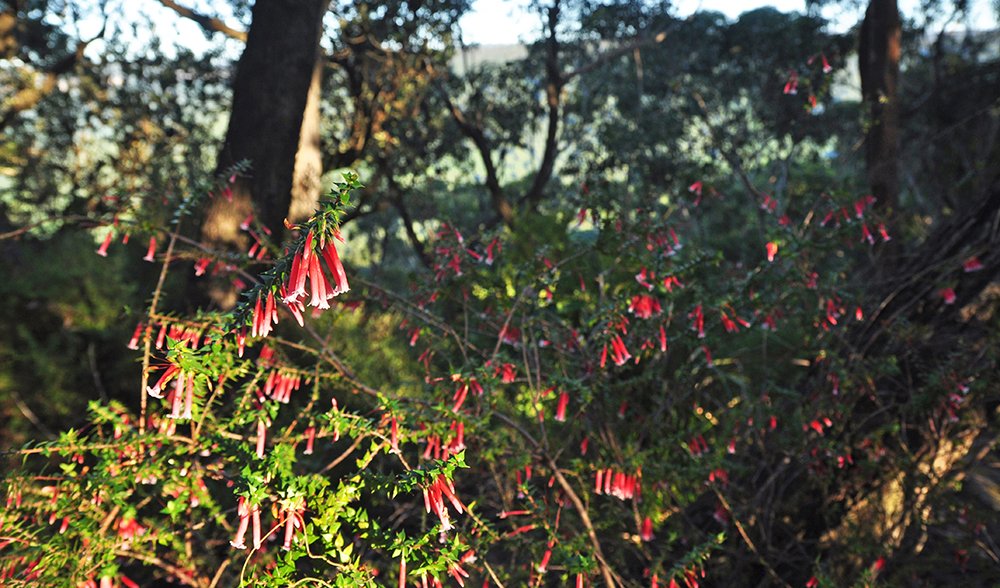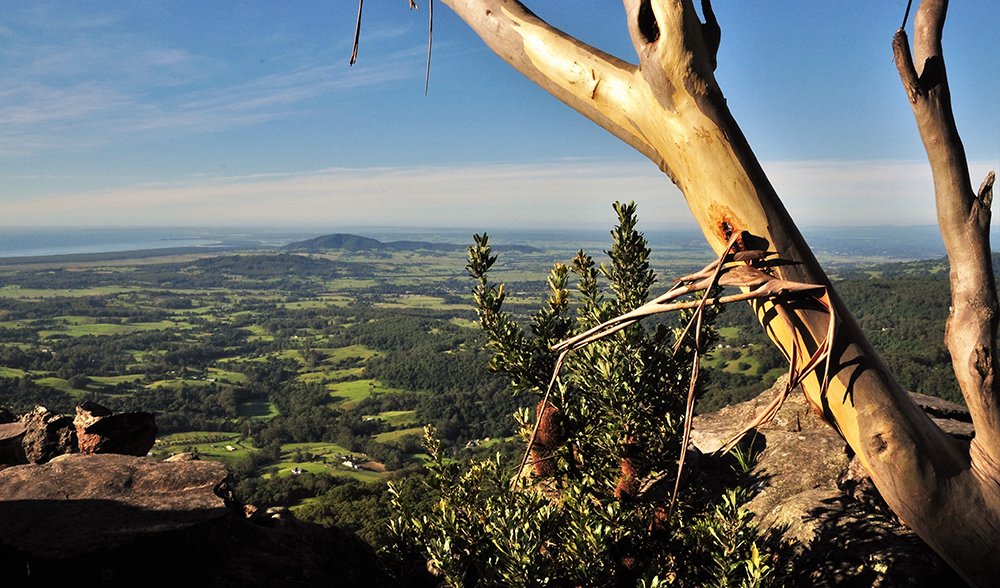Spellbound by Shoalhaven

A VALLEY OF green pastoral lands rolled away to our left, where we had parked the car about 7km outside the village of Berry, NSW, and set off on foot into shadowy, temperate forest.
Camera dangling around my neck, I snapped away at tiny wildflowers, enormous gnarly trees and the towering, pink sandstone flanking the track to our right.
The previous day, my husband and I had braved Friday afternoon peak-hour traffic to head 150km south of Sydney – and now here we were, doing our best to shed any lingering urban residue to truly experience the beauty that surrounded us.
“Sometimes when I come up here in the winter, the valley is shrouded in mist, so you can’t see very far at all,” said our guide Johny Vynes, who was accompanying us on our early morning hike up to Drawing Room Rocks, an escarpment lookout on the western edge of Shoalhaven.

Wildflowers on the hike up to Drawing Room Rocks. (Image: Gemma Chilton)
Johny is the founder of Free Motion Sports, a local adventure sports company that offers everything from guided treks and abseiling to a range of watersports in nearby Jervis Bay, including kneeboarding and wakeboarding. The latter isn’t surprising – a few days before we met him, Johny took out this year’s amateur NSW state championship for wakeboarding.
At a couple of points along the walk, we darted off the track to check out lower lookouts and different vantage points, and at one point we followed the screech of an unfamiliar bird-call that none of us could identify.
Before long the track through dimly lit, lush forest suddenly changed to low-lying, drier heathland. “In spring, this is like walking through a tunnel of flowers,” Johny commented – regularly offering vignettes of the changing personalities of these surroundings he knows so well. It may not have been as vibrant as the height of spring, but we were nonetheless gifted with fascinating foliage and impressively tough, scraggly trees surviving admirably through the summer in this higher, more exposed landscape.
Finally, after the relatively easy 2km climb, we emerged at our destination, Drawing Room Rocks – named for the eroded Hawkesbury sandstone scattered across the wide unfenced plateau, leaving behind rock formations that somewhat resemble an assortment of tables and chairs. While the rocks are impressive, it was the view that demanded our attention – we couldn’t have asked for a better place to orientate ourselves on the first morning of our weekend in Shoalhaven.
Below our 600m vantage point, a patchwork of forest and farmland gave way to the wide blue expanse of Jervis Bay – 102 sq.km of protected waters that formed 15,000 years ago when sea levels rose at the end of the last ice age; now, it is a watersports and nature-lover’s paradise, purportedly home to some of the whitest-sand beaches in the world.

View from Drawing Room Rocks, with Mt Coolangatta visible in the distance. (Image: Gemma Chilton)
Bringing our gaze back onto land, Johny pointed out Mount Coolangatta at 300m above sea level – from this perspective it stood out like a termite mound in a desert, but overlaid with green. Further in the distance, to the south, was the distinctly shaped Pigeon House Mountain, otherwise known as Didthol in the local Aboriginal Dhurga language – meaning ‘woman’s breast’ and referring to that same distinctive shape (in which Captain Cook apparently saw something entirely different when he came up with the English moniker). The relatively achievable hike to Pigeon House Mountain’s 720m summit is one of the main tourist drawcards of this region.
Had I known it then, another Dhurga word might also have sprung to mind in that moment – ‘dulamar’, meaning something magical, something extraordinary, which can’t quite be explained. It’s a word I would learn the following day, over a cup of tea with traditional owner and artist Auntie Julie Freeman, from the Bherrewee community in Wreck Bay, Booderee National Park. Looking back on this moment, I would realise that word, dulamar, would perfectly capture the feeling of quiet awe as we took in the panoramic view before us.
As Johny pointed out the various peaks and sites of significance, he recommended we meet with Julie to learn more about the ancient history of Shoalhaven – her people’s ‘galambin’ (the Dhurga word for ‘home’ or ‘country’), with a significance and beauty to which any weekend adventure jaunt could hardly begin to do justice.
Bay of plenty
Along with other traditional owners from her family and community, Julie runs Galambin, a small tourism business offering visitors Indigenous insights, stories and teachings.
“It’s about experiencing a new worldview on-site. It’s a whole different way of looking at your surroundings, at something that might seem common, but to us it isn’t common,” Julie said as we sipped tea around her dining table, her dog Lilly Pilly asleep at our feet.
In the brief time we had over a cuppa, Julie gave us a glimpse into some of the Bherrewee community’s rich local stories, painting a picture of their ancient connection with the land and in particular the water and the ocean. ‘Booderee’ means ‘bay of plenty’, and Aboriginal people have lived here and thrived from the fruits of these pristine local waters for aeons, since even before the formation of Jervis Bay with the melting of the glaciers.

Murrays Beach, Booderee National Park. (Image: Shoalhaven Tourism)
To Julie, the mountains, the ocean, the waterways and our place within them are inextricably interconnected – from our own moods and the moods of the wind and the water, to the very water that makes up our bodies – so it seems fitting that, that same morning, we had been able to experience her galambin of Shoalhaven anew, from within the waters of Jervis Bay, over which we’d looked from 600m above the previous day.
On the Sunday morning, we’d boarded a boat with local dive company Dive Jervis Bay in the bustling coastal town of Huskisson, accompanied by a group of scuba divers. Our first dive spot for our half-day snorkelling trip was Point Perpendicular, the southern tip of Jervis Bay’s northern headland, Beecroft Peninsula. The point is named for the sheer cliffs that rise almost vertically out of the water, atop which sit Point Perpendicular Lighthouse.
As our skipper killed the engine and dropped anchor, we marvelled at the dramatic geology rising out of the water – it was almost as fascinating as what awaited us beneath the surface.
As Julie might have said, the wind was in a bit of a mood that morning – a little skittish and excitable. Being so close to the bay entrance here, we were a little exposed and the water was choppy – but not enough to detract from the dive.
We donned our gear and leaped in, swimming close to the rocks at the more protected base of the cliff. Within minutes we had spotted a curious blue grouper; hundreds of colourful school fish; a ceiling of delicate, needle-like garfish; and – following the classic snorkeller’s wide-eyed wave-and-point – a big camouflaged wobbegong shark lying still on the seafloor, about 15m below.
Back on the boat, we were warmed up with cups of hot chicken soup as we motored to our next stop – but we didn’t have to wait to be back in the water before Jervis Bay gave us her next show. Hardly 10m from our boat, an enormous marlin leapt several times across the water’s surface, to the whoops of all on board as we scrambled for our cameras – and no doubt to the excitement of the few game-fishing boats bobbing nearby.
We anchored at a site called The Docks, on the northern side of the bay, this time entirely protected from those earlier nor’easters. We could see the stunning clarity of the water from the boat and itched to get in as the instructors pointed out caves and coves we might like to explore.

Jervis Bay is alive with marine life, such as this grouper. (Image: Teresa Williams)
The Docks, named for the way the rocks look from an aerial perspective, is one of Dive Jervis Bay’s most popular sites and it isn’t difficult to see why. As we swam into a cathedral-like cave, the water filling and residing, it was difficult to choose between enjoying the view from above and taking in the diverse sea life thriving below – including an enormous school of rays my husband was lucky enough to witness sailing by just before he re-boarded. “That’s always the way, isn’t it?” Our guide lamented with me as, wetsuit half-unpeeled, I craned my neck overboard trying to catch a glimpse.
So it was with the salt of Jervis Bay still crusted on our skin – a mental map of the aerial view over the entire region still fresh in our minds – that we finished our weekend away sipping tea with Julie that afternoon.
I asked her what she loves most about Shoalhaven, hers and her people’s galambin, and what she thinks draws visitors to the area. “It’s all about its diversity,” she said.
“There’s different types of rainforests, mangrove swamps, marshes, woodlands, wet and dry heaths, wildflowers and orchids, different species of trees and forests.
“You shouldn’t just walk through the bush, you should be looking closely, realising when you’ve just opened a door and walked into an entirely different world. People need a bit of magic in their lives.”
READ MORE:
- Australia’s top paddling spots
- Top 8 whale watching spots in NSW




